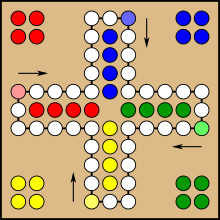Mensch ärgere Dich nicht

Game plan
|
|
| Designer(s) | Josef Friedrich Schmidt |
|---|---|
| Publisher(s) | Schmidt Spiele |
| Publication date | 1914 |
| Genre(s) | Board game |
| Players | 2 to 4 (2 to 6 on reverse side) |
| Setup time | 1 minute |
| Playing time | about 30 minutes |
| Random chance | High (die rolling) |
| Skill(s) required | Counting, probability, strategy |
Mensch ärgere Dich nicht is a German board game (but not a German-style board game), developed by Josef Friedrich Schmidt in 1907/1908.
The game was issued in 1914 and sold about 70 million copies. It is a cross and circle game with the circle collapsed onto the cross, similar to the Indian game Pachisi, the Colombian game Parqués, the American games Parcheesi and Trouble, and the English game Ludo.
The name of the game means "Do not get angry" (literally "Do not get angry, man" or "Do not get angry, buddy"). The name derives from the fact that a peg is sent back to the "out" field when another peg lands on it, similar to the game Sorry!.
The game can be played by 2, 3 or 4 players – one player per board side (the original one has a pattern for 6 players on its backside). Each player has 4 game pieces, which are in the "out" area when the game starts, and which must be brought into the player's "home" row. Early games had painted wooden pieces.
The rows are arranged in a cross position. They are surrounded and connected with a circle of fields, over which the game pieces move in clockwise direction. There are 3 fields nearest to each side of the board; the left one is the player's "start" field (marked "S") and the middle one leads to the "home" row.
This means that each game piece enters the circle at the "start" field, moves (clockwise) over the board and finally enters the "home" row. The first player with all of their pieces in their "home" row wins the game.
The players throw a die in turn and can advance any of their pieces in the game by the thrown number of dots on the dice.
Throwing a six means bringing a piece into the game (by placing one from the "out" area onto the "start" field) and throwing the dice again. If a piece is on the "start" field and there are still pieces in the "out" area, it must be moved as soon as possible. If a piece cannot be brought into the game then any other piece in the game must be moved by the thrown number, if that is possible. Pay attention that throwing dice continuously without moving is forbidden and by each dice throw you have to make a move.
...
Wikipedia
